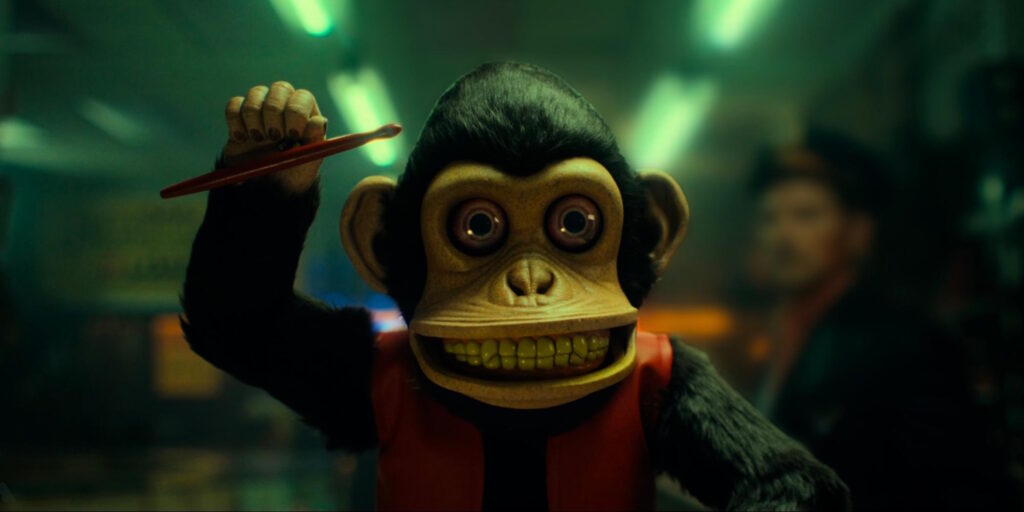[Originally published at Cinema St. Louis’ The Lens.]
While Die Hard (1988) is arguably director John McTiernan’s most beloved and enduring feature, Predator (1987) is his masterpiece: a ludicrous, hyper-juiced, Reagan-era spectacle with a fantastically taut narrative. Expertly blending action and thriller elements with a superficially absurd sci-fi-horror high concept – a technologically advanced alien big-game hunter stalks American special-forces soldiers for sport – the film ingeniously inverts the right-wing fantasy of Rambo: First Blood Part II (1985). The U.S.A. gets its de facto re-do on the Vietnam War in the jungles of Central America, courtesy of the CIA’s late-Cold War geopolitical meddling, only for its steroidal supermen to be annihilated by a solitary guerilla warrior. Working from a screenplay by first-timers Jim and John Thomas, McTiernan caught lightning in a bottle, delivering a deliriously entertaining studio blockbuster, one that feels consistent with other jingoistic actioners of its era, while also presenting a shockingly pessimistic deconstruction of American exceptionalism.
Like most original genre pictures that become box-office hits, Predator spawned its own sprawling franchise, spurting out periodic sequels of diminishing quality, as well as a couple of terrible spinoff-crossovers with the Alien series. In addition to the usual novels, toys, and video games, the Predator brand also includes a surprisingly rich and robust catalog of stand-alone and crossover comic series, the bulk of which were produced by indie publisher Dark Horse Comics in the 1990s. Some of them are genuinely great, most are quite gruesome, and a few are downright goofy. (Archie vs. Predator, anyone?) However, the mainline Predator film series has struggled mightily to recapture even a fraction of the original feature’s lean-and-mean magic, reaching its nadir with Shane Black’s embarrassingly awful The Predator in 2018.
It has taken 35 years for a filmmaker to crack the original specimen’s deceptively simple DNA, but director Dan Trachtenberg’s 18th-century-set prequel Prey finally delivers something that approaches the ferocious potency of McTiernan’s film. It might not save the Predator franchise – the corporate shot-callers at Disney haven’t exactly demonstrated enthusiastic support when it comes to 20th Century Studios properties – but it evinces a heretofore unprecedented understanding of the series’ elemental appeal. Ambitious sci-fi world-building with respect to the Predator species’ culture and history is patently unnecessary. They are a race of towering, grotesque, reptilian humanoids with a passion for intergalactic safari – what else do we need to know? The Predator works best as the secret sauce, the left-field science-fiction swerve in a familiar, straightforward genre scenario. To wit: Trachtenberg (10 Cloverfield Lane) and screenwriter Patrick Aison craft a gritty, colonial-era action epic, throw a hostile alien visitor into the mix, and watch in delight as gore-spattered chaos unfolds.
Granted, the Predator has always been a bit of a one-trick pony. The 1987 original had the advantage of surprise: Like the film’s black-ops commandos, unsuspecting viewers didn’t quite know that they had stumbled out of conservative brushfire fantasy and into a ghoulish sci-fi survival story. Ever since, creators have wrestled with the problem with how to keep the audience invested in a thriller where they – unlike the characters – already understand the enemy and have seen (almost) every trick in his alien-tech arsenal. Aison’s simple but ingenious solution to this challenge is to overlay the Predator template onto a sturdy character arc, such that there are now dramatic stakes beyond waiting in exasperation for the protagonist to catch up with the viewer.
Of course, the 1987 film wasn’t exactly a wellspring of rich characterization, coasting on its murderer’s row of charismatic war-movie archetypes: world-weary badasses, wisecracking cowboys, and whatever the hell Jesse Ventura was doing. Although ostensibly the story’s protagonist, Arnold Schwarzenegger’s Dutch doesn’t really have an arc, beyond his third-act realization that his survival depends on fighting the titular monster with low-tech cunning rather than typical American overkill.
In contrast, Prey presents the viewer with an honest-to-gods character in crisis. In the early 18th century, at the edge of the North American Great Plains, a young Nʉmʉnʉʉ (Comanche) woman named Naru (Amber Midthunder) longs to serve her band as a hunter. Strictly speaking, she is not outright forbidden from such a role. However, hunting is emphatically a men’s endeavor among her people, and her ambitions have been met with disdain and mockery. It doesn’t help that her older brother, Taabe (Dakota Beavers), is the band’s most accomplished and celebrated hunter. While he indulges her dreams to a degree – slyly teaching even as he’s teasing – he also urges her to be realistic. Naru is, after all, already a skilled forager, proficient cook, and learned herbalist. Why must she also aspire to be a tracker, archer, and warrior?
Naru’s motives are simple: She knows that she has the talent to be a truly great hunter, and she’ll be damned if anything as flimsy as tradition will stop her from fulfilling that potential. To Prey’s bountiful credit, it never presents Naru’s ambitions as an expression of some anachronistic, Disney-princess version of contemporary Western feminism. Naru simply loves to hunt, and Trachtenberg employs a clear-eyed but elegant touch when conveying the friction that her headstrong nonconformity causes among the Nʉmʉnʉʉ. When she attempts to join a hunting expedition, one of the men observes with a smirk, “We won’t be gone long enough to need a cook.” More coercive efforts to enforce the group’s customary gender roles prove as futile as they are ugly: When a few scornful hunters become fed up with Naru’s “disobedience” and violently attempt to drag her back to camp, she gives as good as she gets.
However, the Nʉmʉnʉʉ are about to have much larger concerns than one rebellious woman in their midst. While the men are preoccupied with tracking a troublesome mountain lion, Naru discovers curious signs of a much larger predator, a creature (Dane DiLiegro) that walks like a man and slices its way through rattlesnakes, wolves, and grizzly bears with equal ease and enthusiasm. Naturally, her deductions are met with skepticism, and her credibility is further eroded by a mishap during the mountain-lion hunt. However, when Taabe later disappears while stalking this mysterious predator, Naru sets out into the wilds to find her brother and slay the monster herself. What begins as a rite-of-passage quest that will prove her worth to her people soon evolves into life-or-death struggle for survival against the unforgiving elements, rapacious French trappers, and, of course, a singularly lethal visitor from another world.
Simplicity is what enables Prey to succeed so magnificently, both as a long-overdue, worthy successor to Predator and as a rip-roaring stand-alone period action flick. Clocking in at a sinewy but intense 99 minutes, the film eschews unnecessary characters, plot beats, and dialogue, consistently favoring lucid storytelling and visceral thrills. Trachtenberg and his crew deliver an enthusiastically R-rated marathon of horror-flavored action set pieces: brutal hand-to-hand fights, frantic chases, daring escapes, tense ambushes, and (since this is a Predator prequel) elaborate DIY traps. The creature that Naru must confront is distinct from those depicted in previous films, boasting a novel, techno-organic appearance and some new, viciously inventive weaponry. (Does this Predator originate from a different clan or subspecies than those we have seen before? Naru has now way of knowing, so it doesn’t matter. It’s just cool.)
Everyone involved in Prey seems to be firing on all cylinders, as though they felt they had one last shot to redeem the Predator franchise from the limbo of third-rate Hollywood schlock. Stunt coordinators Jeremey Marinas and Steven McMichael orchestrate one dazzling maneuver after another, permitting the film’s action to dance right up to the precipice of movie-magic plausibility. Sound designer James Miller imbues every thwack of Naru’s tomahawk and schlinnggg of the Predator’s alien weaponry with chest-thudding force. Composer Sarah Schachner’s most relevant experience to this project is probably her superlative work on the Assassin’s Creed video-game series, specifically Origins and Valhalla. (The latter seems to have landed her the job.) Her alternately moody and heart-pounding score nods artfully in the direction of Randy Edelman and Trevor Jones (The Last of the Mohicans) and Ryuichi Sakamoto (The Revenant) without ever crossing over into outright homage.
Ultimately, however, one element elevates Prey from a spirited franchise revival into a future action classic: Amber Midthunder. Although she has had recurring roles in television series such as Legion and Roswell, New Mexico, Midthunder here proves her marquee action-star bona fides with a fierce, intensely physical lead performance. She gives both the mortal and emotional stakes of Naru’s quest a legendary weight, without ever losing sight of the role’s grounded humanity. What’s more, she somehow looks spectacular while doing so, turning every stance, every stunt, and every motion into an intoxicating little hit of cinematic euphoria. This is a promise, dear reader: You will never, ever get sick of the sight of Midthunder (or her stunt double Tammy Nera) executing a slow-motion power slide. Or tossing her rawhide-tethered tomahawk and then yanking it back to her hand like she’s Kratos in God of War. Or simply sprinting at full Tom Cruise tilt as if she’s trying to outrun the Devil himself. (Which, one supposes, she sort of is.) Simply put, Midthunder delivers an irresistible action performance, and if the entertainment world is even a little bit just, it will kick-start a career of cinematic badassery to rival that of Milla Jovovich or Charlize Theron.
Prey will be available to stream on Hulu on Friday, Aug. 5.




